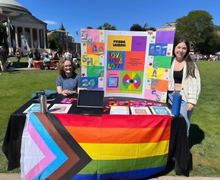Otto the Puppy reunites with littermate in guide dog training program
Xixi Zhou | Contributing Photographer
The Guiding Eyes program trains dogs in the Carrier Dome once a month. The setting of the Dome allows for the dogs to get used to an environment they may end up working in.
They say a dog is a man’s best friend. They’re playmates, loyal companions and something to cuddle with after a long day.
But for some people, their dogs help them navigate through life — literally.
Meet Otto. He’s not the Syracuse University mascot, but the Orange is his namesake. This Otto is a 13-month-old yellow lab currently training to become a guide dog for Guiding Eyes for the Blind.
Since he was 8 weeks old, Otto has lived with junior information management and technology major Kyle Rand and his family in Connecticut. These volunteer puppy raisers have been training him in basic obedience and house manners, and exposing him to the world he’ll see as a guide dog.
Xixi Zhou | Contributing Photographer
Otto is one of many puppies currently training with Guiding Eyes. At any given time, there are about 400 dogs preparing for training with puppy raisers.
On Thursday, the puppies-in-training traveled with their raisers to the Carrier Dome, where they had the opportunity to walk around and greet other people and dogs.
This was Otto’s first visit to Syracuse, where he was able to meet his littermate, Oliver. Though Otto the puppy has been featured on his namesake’s Instagram multiple times, he also got to meet the SU mascot, who stopped by the Dome to pose for pictures with the dogs.
Guiding Eyes has been using the Dome once a month since January to work with the dogs. Working in the Dome allows the dogs-in-training to experience the expansive space and to get used to an environment they may end up working in.
Xixi Zhou | Contributing Photographer
Mary Oonk, co-regional coordinator for the Central New York Region of Guiding Eyes, said she’s grateful for the opportunity to work in an environment like the Dome because it helps create a reference library for the dogs.
“When they become working guide dogs it’s helpful because they have that ‘been there, done that type of thing,’ so they can be confident in guiding their partner through a building like the Carrier Dome in the future,” Oonk said.
This is only one of many hypothetical situations a guide dog experiences during its 18-month training with the puppy raisers before leaving its family and heading off to formal training with Guiding Eyes for the Blind.
This time is often very emotional for the raisers, and it’s something the Rand family has experienced after raising two other dogs before Otto.
Kyle Rand admitted that while the process is a tiring and sometimes big commitment, it’s a gratifying experience.
“Sometimes it’s just the simplest thing, like cuddling a small adorable puppy,” Rand said. “It can be loud at night, but what they cause in frustration sometimes, they make up for with how loveable they are.”
Xixi Zhou | Contributing Photographer
Since its founding in 1954, Guiding Eyes has paired over 7,000 guide dog teams. They match individuals who are visually impaired with the program’s guide dogs. The program is run solely on donations, so those in need of a guide dog can have one without financial burden.
Kari Young has been involved in the program since January of 1999. Since then, she’s received six guide dogs from Guiding Eyes.
Both Young and her sister are visually impaired and graduated with dogs from Guiding Eyes. Young said joining the group was one of the best decisions she’s made. Having a guide dog became her motivation.
“I found myself not wanting to do anything,” Young said. “I didn’t trust myself with a cane, and I decided I didn’t want to live like that so I knew a big change was in order.”
Xixi Zhou | Contributing Photographer
In order to receive each guide dog, Young had to undergo three weeks of training. She’d start a training day around 6 a.m. and would end around 9 p.m. each day. During those hours, Young, along with others, would practice obedience as well as street training with their dogs.
In her free time, Young would teach her dogs commands such as how to work an elevator or even how to find her car.
“Some people look at their dogs as just being a tool but to me, my dog is a person, too,” Young said. “He has feelings, and he was trained for a purpose. If I don’t utilize the gift he’s been given, that doesn’t say much for me.”
Guide dogs are paired with owners based on characteristics such as personality and walking pace. From the moment of pairing, owners and dogs spend all of their time together until a dog reaches retirement.
The need for immediate and complete trust is something Young feels is the hardest part of the program.
“One wrong step and someone could get run over by a car, and I have to trust that when we’re crossing the street … and there’s something there, he won’t go,” Young said. “My life is in his two eyes and his four paws.”
Published on April 10, 2016 at 9:12 pm
Contact Dana: dmatsun@syr.edu









